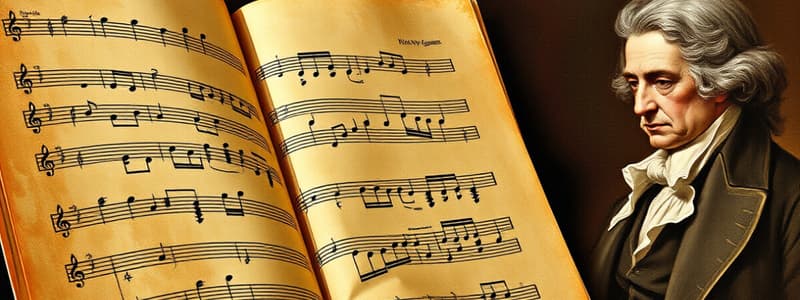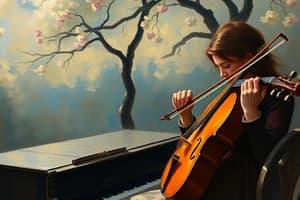Podcast
Questions and Answers
How was the Romantic approach to dynamics different from the Classical?
How was the Romantic approach to dynamics different from the Classical?
- Romantic composers used a much broader range of dynamics (correct)
- Both used the same range of dynamics
- Romantic composers eliminated dynamics altogether
- Romantic composers used a narrower range of dynamics
Which composer's work represents the critical stage of development of the various innovations of the Romantic era?
Which composer's work represents the critical stage of development of the various innovations of the Romantic era?
Richard Wagner
How is Chopin's Prelude in D minor an example of the Romantic approach to melody?
How is Chopin's Prelude in D minor an example of the Romantic approach to melody?
Its melody is freer and more spontaneous than a typical Classical melody
Which is NOT a character type represented in Liszt's 'Faust Symphony'?
Which is NOT a character type represented in Liszt's 'Faust Symphony'?
One of the many new genres on display in the Romantic era is the character piece, a free-standing movement for orchestra often inspired by a non-musical subject.
One of the many new genres on display in the Romantic era is the character piece, a free-standing movement for orchestra often inspired by a non-musical subject.
Franz Liszt's By Lake Wallenstadt begins with lines from a long narrative poem by Lord Byron entitled Childe Harold's Pilgrimage.
Franz Liszt's By Lake Wallenstadt begins with lines from a long narrative poem by Lord Byron entitled Childe Harold's Pilgrimage.
During the Romantic era, composers drew increasing support from the growing middle class.
During the Romantic era, composers drew increasing support from the growing middle class.
Unlike their Classical counterparts, Romantic composers viewed tonality as an orderly, rational system of musical planning rather than another agent of expression.
Unlike their Classical counterparts, Romantic composers viewed tonality as an orderly, rational system of musical planning rather than another agent of expression.
What does 'ritard' refer to?
What does 'ritard' refer to?
What does 'accelerando' refer to?
What does 'accelerando' refer to?
What does 'rubato' refer to?
What does 'rubato' refer to?
Which Classical composer took notice of the young Franz Schubert?
Which Classical composer took notice of the young Franz Schubert?
What did Clara Schumann have in common with W.A. Mozart?
What did Clara Schumann have in common with W.A. Mozart?
Which composer is known for two great song cycles, Die schöne Müllerin and Winterreise?
Which composer is known for two great song cycles, Die schöne Müllerin and Winterreise?
Romantic songwriters found their texts from a variety of sources, but primarily Spanish Ossianic poems.
Romantic songwriters found their texts from a variety of sources, but primarily Spanish Ossianic poems.
After Robert Schumann's death in 1856, the friendship between his wife Clara and budding composer J.Brahms eventually dissipated.
After Robert Schumann's death in 1856, the friendship between his wife Clara and budding composer J.Brahms eventually dissipated.
What does 'thorough-composed' refer to?
What does 'thorough-composed' refer to?
What does 'strophic' refer to?
What does 'strophic' refer to?
What does 'modified strophic' refer to?
What does 'modified strophic' refer to?
How does the composer avoid providing closure at the end of Robert Schumann's 'Im wunderschönen Monat Mai'?
How does the composer avoid providing closure at the end of Robert Schumann's 'Im wunderschönen Monat Mai'?
Which character is speaking in Schubert's Erlkönig, and why?
Which character is speaking in Schubert's Erlkönig, and why?
What type of form does Clara Schumann's 'Liebst du um Schönheit' exhibit?
What type of form does Clara Schumann's 'Liebst du um Schönheit' exhibit?
What do the terms 'damper,' 'sostenuto,' and 'una corda' refer to?
What do the terms 'damper,' 'sostenuto,' and 'una corda' refer to?
Which statement about Chopin's life is NOT true?
Which statement about Chopin's life is NOT true?
After which composer did Fanny Hensel NOT name her son?
After which composer did Fanny Hensel NOT name her son?
Which composer discussed in this chapter was the dominant piano virtuoso of the 19th century?
Which composer discussed in this chapter was the dominant piano virtuoso of the 19th century?
Hensel was the first composer to play solo recitals, concerts in which she appeared alone.
Hensel was the first composer to play solo recitals, concerts in which she appeared alone.
How does the performer create the blurring effect in Chopin's Nocturne in E-flat major?
How does the performer create the blurring effect in Chopin's Nocturne in E-flat major?
What term is used for the extremely loud increase in tempo used in Chopin's Prelude in D minor?
What term is used for the extremely loud increase in tempo used in Chopin's Prelude in D minor?
What device does Liszt use to prepare the listener for the main theme in Petrarch Sonnet No. 104?
What device does Liszt use to prepare the listener for the main theme in Petrarch Sonnet No. 104?
How can you discern that the coda in Hensel's Il Saltarello Romano is present?
How can you discern that the coda in Hensel's Il Saltarello Romano is present?
Flashcards are hidden until you start studying
Study Notes
Romantic Era Characteristics
- Dynamic range in Romantic music was significantly broader compared to Classical music.
- Richard Wagner exemplified the critical innovations of the Romantic period.
Composers and Their Works
- Chopin's Prelude in D minor features a melody that is freer and more spontaneous than Classical melodies.
- Franz Liszt's "Faust Symphony" does not include the character archetype of the valiant warrior.
- Clara Schumann and W.A. Mozart both began their musical education under their fathers, showcasing their prodigious talents.
Music Forms and Techniques
- Ritard: A term indicating a reduction in speed.
- Accelerando: A term used for an increase in speed.
- Rubato: Refers to a flexible approach to rhythm that allows expressive freedom.
- Thorough-composed: A form where new music is composed for each stanza.
- Strophic: A form that uses the same music for each stanza.
- Modified strophic: A form that repeats music with variations from stanza to stanza.
Notable Compositional Elements
- Schubert is recognized for his two significant song cycles: "Die schöne Müllerin" and "Winterreise."
- Romantic songwriters primarily sourced lyrics from diverse origins, excluding just Ossianic poems.
- Chopin's life is contextualized by his later pursuit of success as a public concert pianist.
Performance Insights
- Robert Schumann's "Im wunderschönen Monat Mai" avoids closure by ending on a sustained dissonant chord.
- Schubert's "Erlkönig" utilizes high pitch and frenetic accompaniment to convey the child's perspective.
- Clara Schumann's "Liebst du um Schönheit" exemplifies modified strophic form.
Instrumentation and Pedals
- Piano foot pedals include the damper, sostenuto, and una corda, which affect sound production and tonal quality.
- The blurring effect in Chopin's Nocturne is created using the damper pedal.
Personal Connections and Legacy
- Fanny Hensel did not name her son after Franz J. Haydn and was the first to perform solo recitals.
- Franz Liszt emerged as the dominant piano virtuoso of the 19th century, shaping performance standards.
Performance Techniques
- In Chopin's Prelude in D minor, a loud increase in tempo is termed Stretto.
- Liszt's use of a descending ritardando prepares listeners for the main theme in "Petrarch Sonnet No. 104."
- The coda in Hensel's "Il Saltarello Romano" is discerned through a descending ritardando.
Musicianship and Collaboration
- After the death of Robert Schumann, the friendship between Clara Schumann and Johannes Brahms remained strong and significant.
Studying That Suits You
Use AI to generate personalized quizzes and flashcards to suit your learning preferences.




